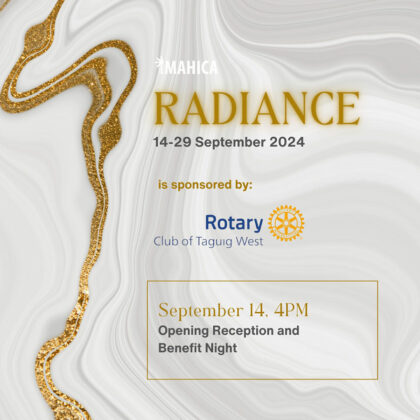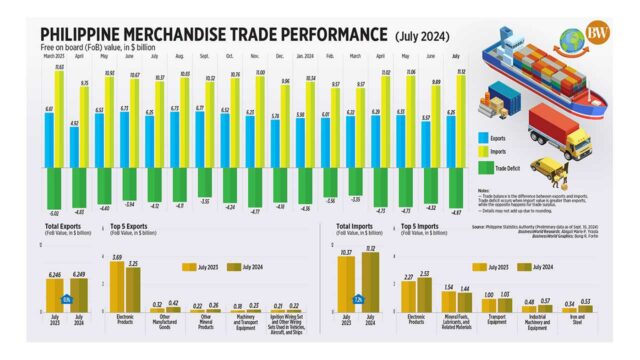Arts & Culture (09/11/24)
Manila International Book Fair kicks off, free for teachers
IN CELEBRATION of National Teachers’ Month (NTM), Primetrade Asia is giving teachers a free pass to the Manila International Book Fair (MIBF) which runs from Sept. 11 to 15 at the SMX Convention Center in Pasay City. There will be a lineup of talks and forums on educational tools, teaching strategies, and teacher wellness. One of these is Kawangis Komiks, which will discuss comics as an educational tool on Sept. 11, 1 p.m. Mental health advocate Amelia De Chavez Pagdanganan, also known as Lolakwentosera, will share her ideas on building a support system for teachers on Sept. 11, 2 p.m. The Gintong Aklat Awards will be held on Sept. 11, 4 p.m., by the Book Development Association of the Philippines, while the awarding of the Lampara Prize for children’s books will happen on Sept. 13, 1:30 p.m. The Council for People’s Development and Governance will host a forum for teachers who work closely with indigenous peoples on Sept. 14, 12 p.m. Finally, the National Children’s Book Awards will take place on Sept. 14, 4 p.m. To see the complete list of exclusive offers for teachers this National Teachers’ Month, visit www.facebook.com/NTMPhils.
Alliance Française holds improv night
AS PART of the exhibition Trajectories and Movements of Filipino People by the Pamana Voices of Philippine Heritage, which opened last weekend, there will be a cultural activity to further enrich visitors’ experience. An improv night titled “Doon Po Sa Amin” (Where We’re From) will take place on Sept. 12 at 7 p.m. at the Multipurpose Hall of the Alliance Française de Manille, Nicanor Garcia St., Makati City. Admission to the event is free. For more details, visit Alliance Française’s website and social media pages.
ICanServe auctions pieces from its gallery for good
THERE ARE 27 pairs of Nike Air Force 1 Triple White shoes which have been transformed into one-of-a-kind pieces by contemporary Filipino artists to make up the Icons of Hope exhibit at level two of The Brittany Hotel in Bonifacio Global City, Taguig. For its 25th anniversary, the ICanServe Foundation will auction off the pieces on Sept. 14. Artists who participated include Benedicto “BenCab” Cabrera, Gus Albor, Arce, Max Balatbat, Plet Bolipata, Elmer Borlongan, Jinggoy Buensuceso, Carlo Calma, Katrina Cuenca, RM De Leon, Daniel dela Cruz, Monica Delgado, Tracie Anglo Dizon, Christina Dy, Manny Garibay, Toym Imao, Jose Santos III, Pam Yan Santos, Gerry Tan, Carlo Tanseco, Vien Valencia, Lydia Velasco, Ronald Ventura, Melissa Yeung Yap, and MM Yu. Proceeds will enable ICanServe to fund treatments and medical procedures for breast cancer patients, launch high-impact health literacy campaigns, invest in the training of public healthcare workers on early detection, and create breast cancer control programs, to support its mission of saving lives. To download the online catalog, registration form, and auction mechanics, visit: https://www.icanservefoundation.org/events/the-pink-room/.
Two families exhibit at ARTablado Antipolo
ARTISTS and friends Brando Limon Bati and Adler Llagas had a two-man show at ARTablado Robinsons Antipolo two years ago. This year, they return with each of their families for an unprecedented “two-family” exhibit. Dreams to Reality, which runs until Sept. 15, celebrates the creativity and connections of the two men and their wives and daughters. Mr. Bati, from Tanay, Rizal, is known for painting figures and still life using oil, pastel, colored pencils, and watercolor. Mr. Llagas, from Baras, Rizal, is a self-taught landscape artist who participates in exhibitions and paints commissioned murals. Their wives, Teresa and Lucia, were influenced by their husbands’ active art careers to go into the field. This later carried over to their daughters, Candys and Aicel. Dreams to Reality runs until Sept. 15 at ARTablado on the upper ground floor of Robinsons Antipolo.
UST Atelier holds exhibit at ArtistSpace
A GROUP exhibition titled Vision: Arcadia by the UST Atelier Alumni Association, Inc. is on view until Sept. 22 at ArtistSpace. A continuation of the group’s Vision Art Exhibition Series, the show celebrates artistic diversity and the contribution of the University of Santo Tomas’ School of Fine Arts to the Philippine art scene. The participating artists are Fil Delacruz, Richard Buxani, Marge Organo, Emman Acasio, Cristina Alsol, Juert Asejo, Paul Balan, RV Basco, Janos Delacruz, Elmer Dumlao, Summer de Guia, Anna de Leon, Noli Principe Manalang, Patrick Naval, Milmar Onal, Butch Payawal, David Requilme, Dominic Rubio, Gean Sollestre, Melissa Villaseñor, and Meneline Wong, MD. It is a project of USTAAAI President Marissa Pe Yang, curated by Janos Delacruz. Vision: Arcadia runs until Sept. 22 at ArtistSpace, Ayala Museum Annex, Makati Ave. corner De La Rosa St., Greenbelt Park, Makati City.
Group exhibition at Imahica Art Gallery
THE GROUP exhibition and benefit show Radiance is happening from Sept. 14 to 29 at the Imahica Art Gallery, in partnership with Rotary Club Taguig West. The exhibition aims to be a display of artistic excellence and is being held in support for impoverished communities at the Tenement Elementary School and Western Bicutan National High School. The opening reception and benefit night is set for Sept. 14, 4 p.m. To register, visit https://imahica.art/rsvp/. The gallery is at 2-A Lee Gardens Commercial Center, Lee St., Wack-Wack, Mandaluyong.
Group show opening at MO_Space
ANOTHER group exhibit, titled THESE ACTS, _________, is a two-part exhibition with Act I and Act II assembling art dialogues. Using various media, it aims to expose gallery visitors to different art forms. Act I presents an immersive experience with artworks like pottery and visual art, focused on the act of looking up and outward to form an understanding of the world. Act II makes use of prints where artists look inward to form an understanding of the self. These will be on view from Sept. 14 to Oct. 13 at the Main Gallery and Gallery 2 of MO_Space. Act I will feature works by Micaela Benedicto, Gerecho Iniel Cruz, Rhaz Oriente, and Marco Rosario. Act II presents the prints of Eska Beldia, Kristen Cain, Marge Chavez, Gab Ferrer, Tish Hautea, Fara Manuel, and Gabi Nazareno. MO_Space is at the 3rd level of MOs Design, B2 Bonifacio High Street, 9th Avenue, BGC, Taguig.
Ateneo Art Gallery presents the postwar art scene
IN COMMEMORATION of the Fernando Zóbel’s birth centennial, the Ateneo Art Gallery and the Embassy of Spain are presenting A Synergy of Ventures: The Postwar Art Scene, which will open for public viewing on Sept. 16 at the Ateneo Art Gallery, Ateneo de Manila University, Kalayaan Ave., Quezon City. The exhibit will run until July 12, 2025. The exhibition will focus on presenting the years immediately following the Second World War until the 1960, a pivotal period in the development of Philippine modern art. An opening reception will take place on Sept. 15, 2 p.m., at the gallery’s upper ground floor. The show’s contents come from the core collection Fernando Zóbel had donated to the Ateneo de Manila University between 1959 to 1965, along with other pieces from the current AAG Collection. It will also feature loaned works from the family of Purita Kalaw Ledesma, the Kalaw-Ledesma Foundation, Inc., and the Cultural Center of the Philippines.





















